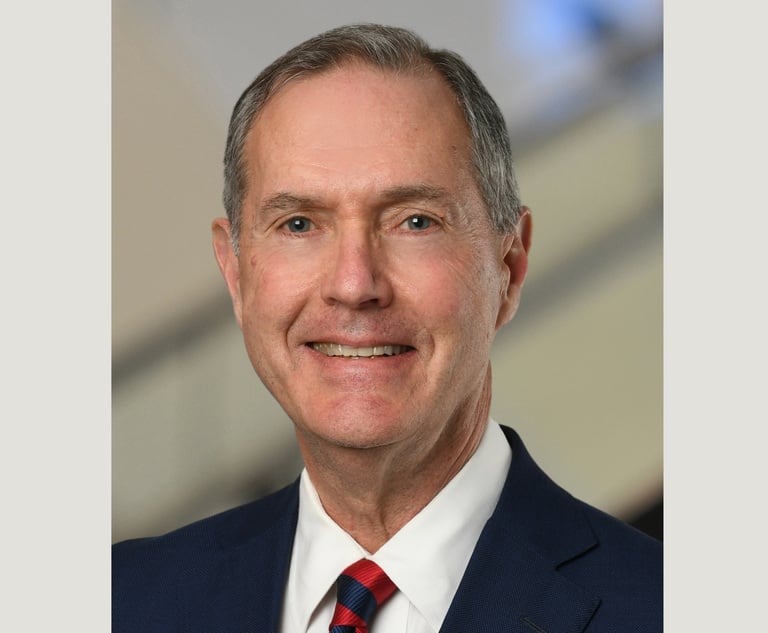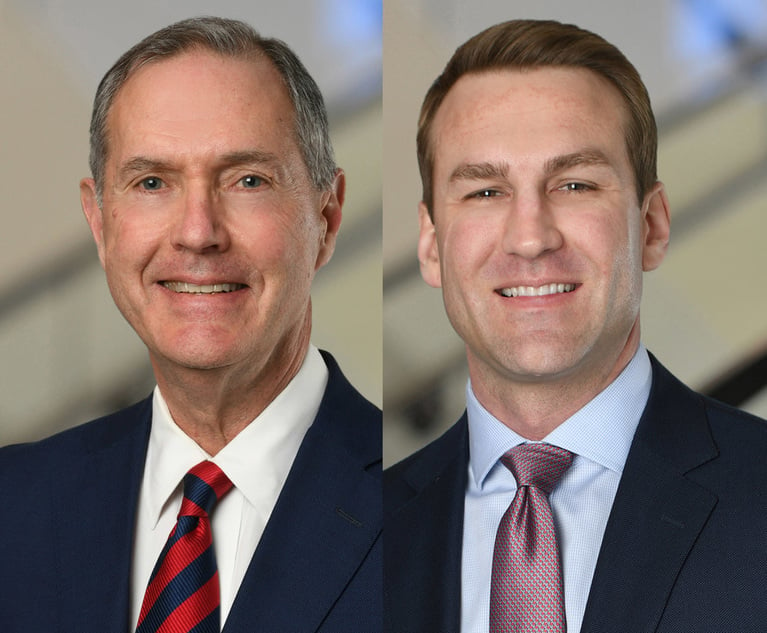Strong Demand Fuels Growth for Big Four Labor and Employment Firms
Business has been booming for the top-grossing U.S. labor and employment law firms: Littler, Ogletree, Jackson Lewis and Fisher Phillips.
April 11, 2019 at 04:40 PM
10 minute read
 (Photo: Shutterstock)
(Photo: Shutterstock)
The country's largest labor and employment firms enjoyed strong growth in 2018, thanks to high demand that has been spurred by litigation, new laws and regulations, multinational clients and the #MeToo era.
But each of the four top-grossing U.S. firms—Littler Mendelson; Ogletree, Deakins, Nash, Smoak & Stewart; Jackson Lewis; and Fisher & Phillips—has relied on its own model for growth, ranging from differences in partnership structure and international strategy to the firms' specific practice priorities and investments in technology.
Revenue and Head Count Gains
With more than 1,000 lawyers, Littler is the largest of the four, followed by Ogletree, Jackson Lewis and Fisher Phillips.
 Thomas Bender
Thomas BenderTom Bender, the co-president of Littler with Jeremy Roth, said it was an “incredibly strong” year for the firm. “Financially it was very, very good. That may be even a bit of an understatement.”
What's more, Bender said, the firm made “major strides” in global expansion, tech and innovation, and diversity and inclusion.
At Littler, revenue grew an estimated 8.6 percent to $584.2 million, pushing up revenue per lawyer 6 percent to $547,000. (The firm discloses only head count data; revenue and profit figures are derived by ALM.)
Littler's overall lawyer head count increased 2.4 percent to 1,068 lawyers for its U.S. offices. Globally the firm has more than 1,500 lawyers, but Littler Global is structured as a Swiss verein, so the U.S. branch is a separate financial entity.
 Matt Keen
Matt KeenOgletree's managing shareholder, Matt Keen, also said his firm saw “strong growth” across practices, adding that immigration, class actions, workplace safety, ERISA and traditional labor matters were busy areas last year.
Ogletree's revenue increased 8.6 percent to $509.8 million, resulting in a 5.4 percent RPL increase to $602,000. Total lawyer head count increased 3 percent to 847 lawyers.
At Jackson Lewis, co-chair Kevin Lauri said social forces and state legislatures “have driven tremendous demand for our services.”
 Kevin Lauri
Kevin LauriLauri, who is in New York City, and Will Anthony, in Albany, New York, became Jackson Lewis' new co-chairs in January.
Jackson Lewis grew revenue 6.4 percent to $447.5 million, but RPL declined 2 percent to $534,000. The firm added a net of 67 new lawyers last year, increasing lawyer head count by 8.6 percent to 838. Lauri said a lot were associates with lower billing rates, which pushed down RPL a bit.
The #MeToo movement has raised awareness among employees about inappropriate treatment, Lauri said, and jurisdictions in New York, California and other states have passed new laws requiring mandatory harassment training and employee protections around gender identity, pregnancy and other issues, as well as benefits such as paid lactation breaks.
 Will Anthony
Will Anthony“Lots of new state legislators have created new protections,” Lauri said. “We are out there educating our clients on what their obligations are.”
He added that demand for litigation services remained strong, while it increased for wage and hour class action work, employee benefits and workplace safety.
Fisher Phillips increased revenue 9.5 percent to $200.7 million, while increasing RPL 3.1 percent to $572,000.
 Roger Quillen
Roger QuillenFisher Phillips' chair, Roger Quillen, reported that the firm has been very busy in states with aggressive enforcement regimes, because the federal regulatory framework for labor and employment issues continues to lag. New laws and regulation around gender pay equity and medical and recreational marijuana have also created new work.
Partner Profits
While the labor and employment firms' RPL clustered in a range from $534,000 at Jackson Lewis to $602,000 at Ogletree, there was more of a spread on profit per equity partner. That was because the firms have widely varying ratios of equity to income partners.
Ogletree led the pack in partner profits. A net income jump of 12 percent ($146.4 million) pushed up PEP by 7.3 percent to $776,000. But Ogletree also has the lowest ratio of equity to income partners. Its 189 equity partners make up less than half (47 percent) of its total partnership.
Jackson Lewis reported a sizable 9.8 percent hike in net income, which reached $153.8 million and pushed up PEP 5.2 percent to $603,000. The firm's 255 equity partners make up 57 percent of the total partnership.
At Fisher Phillips a 4.7 percent increase in net income (to $70.1 million) hiked PEP by 3.6 percent to $574,000. Fisher Phillips has twice as many equity partners (122) as income partners (62).
Littler has three times the number of equity partners (381) as nonequity ones (119), which makes its PEP relatively lower at $521,330. Net income increased 11.9 percent (to $198.6 million) pushing up PEP 13.1 percent.
If the firms are compared on the basis of profit per lawyer, however, there is only a $27,000 spread. Fisher Phillips leads the pack with PPL of $199,786, followed by Littler with PPL of $185,980. That's followed by Jackson Lewis with PPL of $183,518. Despite having the highest PEP, Ogletree has the lowest PPL at $172,792.
International vs. U.S.
Littler has been the most aggressive of the four firms in expanding internationally. Of its 81 offices, 26 are outside the United States. Littler started with a Venezuela location in 2010 and quickly expanded into Latin America and Canada, then in 2015, Europe, with a German office.
Last year, the firm added another German office in Frankfurt, plus locations in Italy, Belgium and the Netherlands, followed this year by Norway. It also opened U.S. offices in Madison, Wisconsin; Salt Lake City; and Greenville, South Carolina, while closing another in Columbia, South Carolina.
 Jeremy Roth
Jeremy RothLittler opted to open its own offices abroad instead of using an international law firm alliance to provide “a coordinated service solution” for multinational clients, said Roth, the firm's co-president. “We are really trying to be one firm.”
Five of Ogletree's 53 offices are international—in Mexico City, Toronto, London, Paris and Berlin. Keen said the decision to add offices abroad, starting with Berlin and London just over six years ago, was client-driven, as companies Ogletree serves asked for help elsewhere. The firm opened one U.S. office last year in Portland, Maine.
Jackson Lewis and Fisher Phillips have steadily expanded their U.S. coverage—Jackson Lewis has 60 offices, and Fisher Phillips has 33—but both firms provide clients legal expertise outside the United States through international law firm alliances.
Jackson Lewis' Lauri said they've considered international offices but so far “we've been successful meeting client needs through our L&E Global alliance.”
Jackson Lewis didn't add any offices last year, but it added several large groups, including 15 lawyers in St. Louis at the beginning of the year, led by labor attorney R. Michael Lowenbaum, from his firm, Lowenbaum Law. (Another national labor and employment firm, FordHarrison, subsequently poached five lawyers in St. Louis from Jackson Lewis to start its own office there.)
Fisher Phillips didn't add offices either in 2018, but it made significant lateral hires in Washington, recruiting Theresa Connolly from Constangy, Brooks, Smith & Prophete to lead the office, and then in January acquiring six-lawyer boutique The Farrington Law Firm, led by Dan Farrington, as Connolly's office co-leader.
Tech Investments
Legal technology has become a significant expense for labor and employment firms, as they jockey to offer clients new products to help them track cases and expenditures—ideally, more efficiently.
Littler has made significant investments to stay at the forefront. The firm in 2010 rolled out CaseSmart, which offers flat-fee pricing on single-plaintiff and class action litigation (although clients can opt for hourly rates) using flex-time lawyers. A dashboard allows clients to track their cases' progress across venues.
So far, more than 1,300 clients have used CaseSmart to handle about 20,000 litigation matters, the Littler leaders said, with annual increases in case volume and the number of flex-time lawyers. “It's become a pretty significant part of our revenue and net,” said co-president Bender.
Clients like it, Bender said, because it's more cost-effective, and the dashboard allows them to survey their case landscape and “see what the hot spots are” for a case type or region.
“The value-add is not just the alternative staffing and fixed or flat-fee pricing,” Roth added, “It's the data.” Clients can mine that “to be proactive in heading off problems,” he explained. “That part is really starting to catch on with the client community.”
For instance, clients can easily check how their company has handled past cases and what they've settled for, Bender said. “Clients are more and more looking for that type of information.”
Last year Littler rolled out a new pay equity tool that clients can use to assess employee pay by region, demographics, type of jobs or operational roles. “Clients were overwhelmed and tired of looking at regression analysis using equations,” Roth said. The new offering has been popular, he said, because it allows clients to look at data more intuitively with “heat-map visuals.”
Jackson Lewis was named Innovative Law Firm of 2018 by the International Legal Technology Association, which cited the firm's web-based tool, workthruIT, which helps clients stay abreast of new laws and regulations. It covers topics such as pay transparency laws, sexual harassment training and investigations, minimum wage requirements, paid sick leave, disability and health management.
Ogletree was able to derive 40 percent of its revenue last year from alternative fees, Keen said, because of its internal knowledge management program, which allows all of its lawyers to access prior work product.
The firm has formed an exclusive partnership with a new tech startup, LegalMation, to develop a tool to produce draft answers to complaints and discovery requests. “It's an area where using AI and machine learning can perform work more efficiently and save clients money,” Keen said.
At Fisher Phillips, Quillen said his firm increased its usual IT spend by $3 million last year to continue investing in IT upgrades last year. That included data analytics and knowledge management to make pricing and case outcomes more predictable for clients.
This content has been archived. It is available through our partners, LexisNexis® and Bloomberg Law.
To view this content, please continue to their sites.
Not a Lexis Subscriber?
Subscribe Now
Not a Bloomberg Law Subscriber?
Subscribe Now
NOT FOR REPRINT
© 2025 ALM Global, LLC, All Rights Reserved. Request academic re-use from www.copyright.com. All other uses, submit a request to [email protected]. For more information visit Asset & Logo Licensing.
You Might Like
View All
Law Firms Expand Scope of Immigration Expertise Amid Blitz of Trump Orders
6 minute read
Losses Mount at Morris Manning, but Departing Ex-Chair Stays Bullish About His Old Firm's Future
5 minute read
Bass Berry & Sims Relocates to Nashville Office Designed to Encourage Collaboration, Inclusion
4 minute read
Gunderson Dettmer Opens Atlanta Office With 3 Partners From Morris Manning
3 minute readTrending Stories
- 1Uber Files RICO Suit Against Plaintiff-Side Firms Alleging Fraudulent Injury Claims
- 2The Law Firm Disrupted: Scrutinizing the Elephant More Than the Mouse
- 3Inherent Diminished Value Damages Unavailable to 3rd-Party Claimants, Court Says
- 4Pa. Defense Firm Sued by Client Over Ex-Eagles Player's $43.5M Med Mal Win
- 5Losses Mount at Morris Manning, but Departing Ex-Chair Stays Bullish About His Old Firm's Future
Who Got The Work
J. Brugh Lower of Gibbons has entered an appearance for industrial equipment supplier Devco Corporation in a pending trademark infringement lawsuit. The suit, accusing the defendant of selling knock-off Graco products, was filed Dec. 18 in New Jersey District Court by Rivkin Radler on behalf of Graco Inc. and Graco Minnesota. The case, assigned to U.S. District Judge Zahid N. Quraishi, is 3:24-cv-11294, Graco Inc. et al v. Devco Corporation.
Who Got The Work
Rebecca Maller-Stein and Kent A. Yalowitz of Arnold & Porter Kaye Scholer have entered their appearances for Hanaco Venture Capital and its executives, Lior Prosor and David Frankel, in a pending securities lawsuit. The action, filed on Dec. 24 in New York Southern District Court by Zell, Aron & Co. on behalf of Goldeneye Advisors, accuses the defendants of negligently and fraudulently managing the plaintiff's $1 million investment. The case, assigned to U.S. District Judge Vernon S. Broderick, is 1:24-cv-09918, Goldeneye Advisors, LLC v. Hanaco Venture Capital, Ltd. et al.
Who Got The Work
Attorneys from A&O Shearman has stepped in as defense counsel for Toronto-Dominion Bank and other defendants in a pending securities class action. The suit, filed Dec. 11 in New York Southern District Court by Bleichmar Fonti & Auld, accuses the defendants of concealing the bank's 'pervasive' deficiencies in regards to its compliance with the Bank Secrecy Act and the quality of its anti-money laundering controls. The case, assigned to U.S. District Judge Arun Subramanian, is 1:24-cv-09445, Gonzalez v. The Toronto-Dominion Bank et al.
Who Got The Work
Crown Castle International, a Pennsylvania company providing shared communications infrastructure, has turned to Luke D. Wolf of Gordon Rees Scully Mansukhani to fend off a pending breach-of-contract lawsuit. The court action, filed Nov. 25 in Michigan Eastern District Court by Hooper Hathaway PC on behalf of The Town Residences LLC, accuses Crown Castle of failing to transfer approximately $30,000 in utility payments from T-Mobile in breach of a roof-top lease and assignment agreement. The case, assigned to U.S. District Judge Susan K. Declercq, is 2:24-cv-13131, The Town Residences LLC v. T-Mobile US, Inc. et al.
Who Got The Work
Wilfred P. Coronato and Daniel M. Schwartz of McCarter & English have stepped in as defense counsel to Electrolux Home Products Inc. in a pending product liability lawsuit. The court action, filed Nov. 26 in New York Eastern District Court by Poulos Lopiccolo PC and Nagel Rice LLP on behalf of David Stern, alleges that the defendant's refrigerators’ drawers and shelving repeatedly break and fall apart within months after purchase. The case, assigned to U.S. District Judge Joan M. Azrack, is 2:24-cv-08204, Stern v. Electrolux Home Products, Inc.
Featured Firms
Law Offices of Gary Martin Hays & Associates, P.C.
(470) 294-1674
Law Offices of Mark E. Salomone
(857) 444-6468
Smith & Hassler
(713) 739-1250






